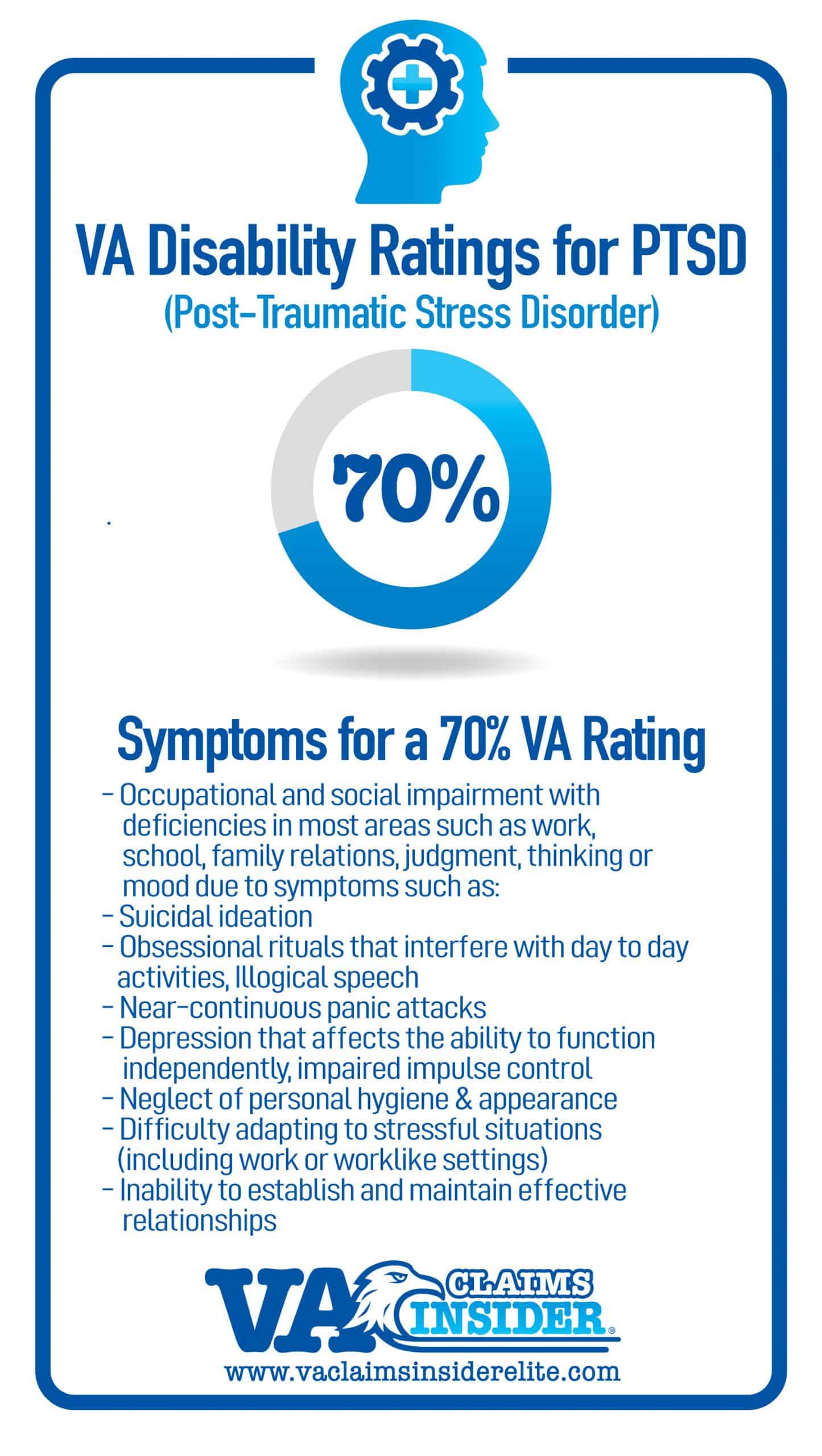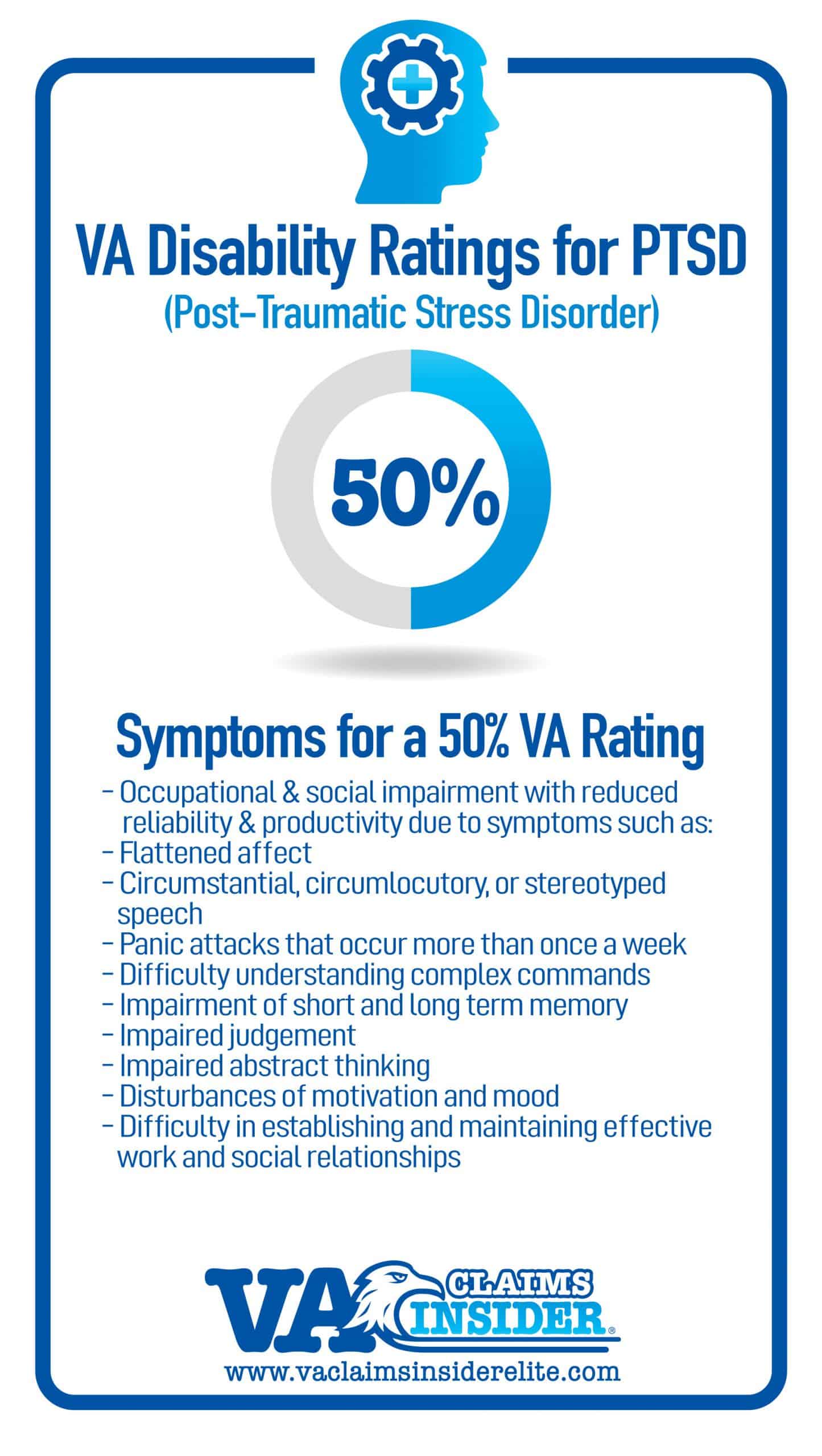Looking for Expert-Level VA Claim Answers?📱Call Us Now! 737-295-2226
In this post, we will be exploring the 70 VA disability for PTSD rating in detail.
So let’s take a minute to explore the law regarding the level of occupational and social impairment required to meet the 70 PTSD rating.
Think you deserve a 100 VA disability rating for PTSD? Click HERE to read now.
PTSD among the easiest VA disability claims to win
According to the easiest VA claims to win data, PTSD is in the top 3 across all groups of veterans.
25.9% of all VA disability recipients for PTSD have a 50 PTSD rating.
28.0% of all VA claim recipients for PTSD have a 70 VA disability for PTSD rating.
And 13.1% have a 100 PTSD rating.
eCFR Title 38, Part 4, the Schedule for Rating Disabilities lists the general rating formula for all mental disorders, including PTSD.
PTSD is rated on a scale from 0 percent to 100 percent, with breaks at 10, 30, 50, and 70.
The 70 VA disability for PTSD rating has fairly severe occupational and social impairment criteria and includes symptoms as follows.
Should I apply for PTSD claim? Click HERE to read now.
70 VA Disability for PTSD Criteria

“Occupational and social impairment, with deficiencies in most areas, such as work, school, family relations, judgment, thinking, or mood, due to such symptoms as: suicidal ideation; obsessional rituals which interfere with routine activities; speech intermittently illogical, obscure, or irrelevant; near-continuous panic or depression affecting the ability to function independently, appropriately and effectively; impaired impulse control (such as unprovoked irritability with periods of violence); spatial disorientation; neglect of personal appearance and hygiene; difficulty in adapting to stressful circumstances (including work or a worklike setting); inability to establish and maintain effective relationships.”
Whereas the 50 PTSD rating is noticeably less severe, and includes the following symptoms:
50 VA disability rating for PTSD criteria

“Occupational and social impairment with reduced reliability and productivity due to such symptoms as: flattened affect; circumstantial, circumlocutory, or stereotyped speech; panic attacks more than once a week; difficulty in understanding complex commands; impairment of short- and long-term memory (e.g., retention of only highly learned material, forgetting to complete tasks); impaired judgment; impaired abstract thinking; disturbances of motivation and mood; difficulty in establishing and maintaining effective work and social relationships.”
A big misconception among veterans is that you need to meet ALL the subjective symptoms tied with a certain rating criterion for PTSD in order to get that rating.
This is simply not true.
The Rating Veteran Service Representative (RVSR) will consider all the evidence of record, and normally will assign the VA rating for PTSD that includes the “preponderance of the symptoms.”
For example, if a veteran has 3 of the symptoms from the 50 rating for PTSD criteria and 5 of the symptoms from the 70 VA disability for PTSD rating criteria, the rating agency shall assign the higher rating, unless evidence of record contradicts this subjective assessment.
The opposite is also true.
For example, if a veteran has 5 of the symptoms from the 50 rating for PTSD criteria and 3 of the symptoms from the 70 PTSD VA rating criteria, the rating agency shall assign the lower rating, unless evidence of record contradicts this subjective assessment.
Two Rules for PTSD VA Ratings
According to §4.126, evaluation of disability from mental disorders, the RVSR (VA Rating Official) is required to consider these two rules:
(1) When evaluating PTSD, the rating agency shall consider the frequency, severity, and duration of psychiatric symptoms, the length of remissions, and the veteran’s capacity for adjustment during periods of remission.
The rating agency shall assign an evaluation based on all the evidence of record that bears on occupational and social impairment rather than solely on the examiner’s assessment of the level of disability now of the examination.
(2) When evaluating the level of disability for PTSD, the rating agency will consider the extent of social impairment but shall not assign an evaluation solely on the basis of social impairment.
How to File a VA Claim for PTSD
If you think you deserve a VA rating for PTSD, or you think you deserve a higher rating for PTSD, you should read “How to File a VA Claim for PTSD” now.
Become an Insider
We’re Veterans helping Veterans Worldwide™, and since 2016 we’ve helped 10,000+ Veterans just like you INCREASE their VA disability rating!
About the Author

Brian Reese
Brian Reese is a world-renowned VA disability benefits expert and the #1 bestselling author of VA Claim Secrets and You Deserve It. Motivated by his own frustration with the VA claim process, Brian founded VA Claims Insider to help disabled veterans secure their VA disability compensation faster, regardless of their past struggles with the VA. Since 2013, he has positively impacted the lives of over 10 million military, veterans, and their families.
A former active-duty Air Force officer, Brian has extensive experience leading diverse teams in challenging international environments, including a combat tour in Afghanistan in 2011 supporting Operation ENDURING FREEDOM.
Brian is a Distinguished Graduate of Management from the United States Air Force Academy and earned his MBA from Oklahoma State University’s Spears School of Business, where he was a National Honor Scholar, ranking in the top 1% of his class.




